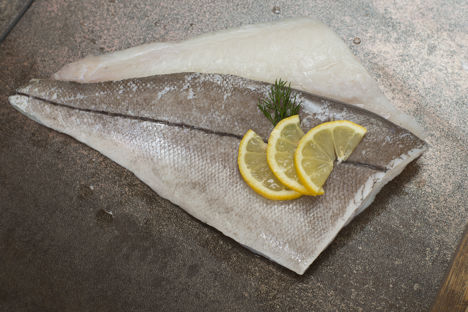Haddock is a popular choice of fish, commonly associated with the popular British dish of ‘fish and chips’. Haddock is a white fleshed fish, often compared to cod in flavour, that can be purchased smoked or unsmoked, dyed or undyed. The smoked haddock coloured garish saffron has usually been ‘smoked’ by flavourings or by modern methods, then dyed. Traditional, undyed smoked haddock is naturally off-white or pale yellow.
Haddock can be recognized by the black line running along the side of haddock and a distinct black thumbprint on its side. Haddock is found around the North Atlantic at its peak season is during the winter and spring months. In spring, haddock roe can also be brought which can be poached or fried. Like cod, haddock has been overfished so eat sparingly or buy sustainably – look for line-caught or the Marine Stewardship Council (MSC) logo. Even better, opt for comparable white fish such as coley and pollock.
What to look for when buying haddock
Haddock is usually available in fillets but can also be bought whole or in steaks, always choose as fresh as possible. Fresh haddock will have firm, pearly white unblemished flesh and smell of the sea, not at all unpleasant. To tell if a whole haddock is fresh have a look at the eyes and gills which should be bright and clear and red, respectively.
How to cook haddock
As with all white fish, haddock can be tricky to get right at first, but with care and practice it's easy to master this delicately-flavoured fish. Fear of undercooking often results in overcooked fish - take off the heat when the fish is just starting to flake and is hot in the middle, the residual heat will finish off cooking the fish while you're plating up.
Cooking haddock whole
Baking haddock is a superb way to cook a whole haddock. Ensure that it’s been gutted, gills and scales removed (which can be done by the fishmonger). Like most whole fish, haddock can also be barbecued, cooked en-papillote or roasted. If you’re roasting haddock add a generous amount to the cavity of a whole fish and into the slashed flesh before cooking - this will add a depth of flavour. For a rough guide, roast haddock for around 12-15 minutes per 1lb of weight at 200°C/gas mark 6. To check that the fish is hot all the way through insert a skewer into the thickest part – it should come out hot, the flesh should also be flaky.
Cooking haddock fillet
Haddock fillets are readily available from your fishmonger. When cooking a haddock fillet, make sure that it has been pin-boned first. Battered haddock is probably the most popular method, but try pan-frying or cooking en-papillote. To crisp the skin of haddock when pan-frying, place it skin-side down in a preheated pan for a majority of the cooking time, and only turn it over in the last minute to finish it off.
What to serve haddock with
With its subtle flavour and soft texture, haddock is a fish that relies heavily on other ingredients on the plate. Haddock is typically served battered with a classic accompaniment of tartare sauce and chips. Potato with haddock is a common staple, often in northern European cooking. Potatoes with smoked haddock are the basis of and the Scottish soup known as Cullen skink. In addition smoked haddock is associated with egg dishes such as in Nathan Outlaw’s Kedgeree or the famous Savoy breakfast dish of Arnold Bennett.
Get in touch
Please sign in or register to send a comment to Great British Chefs.



